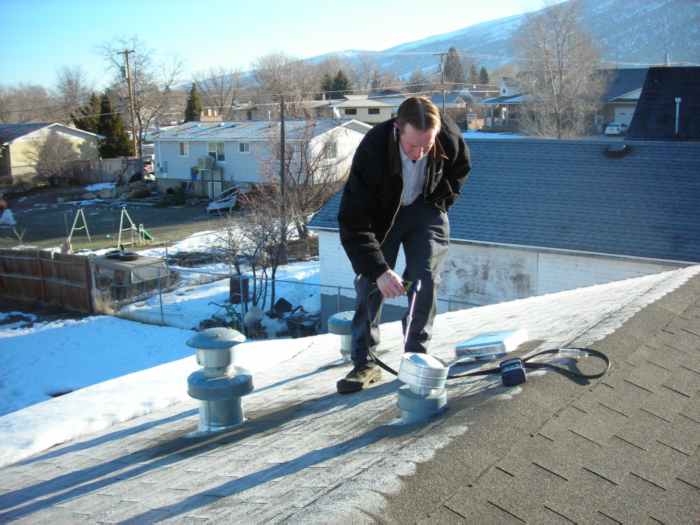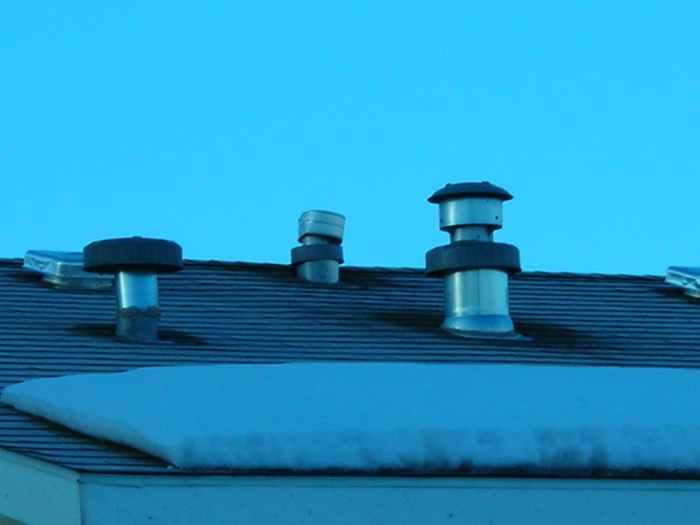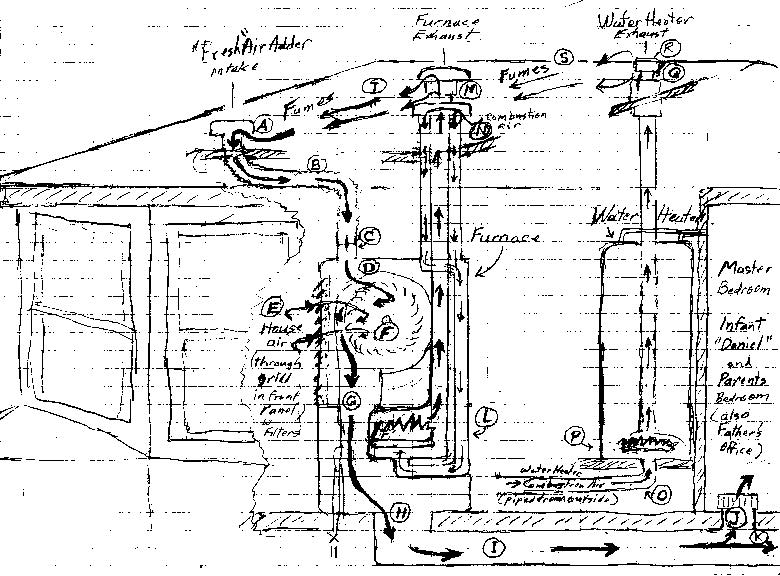 Heating and Venting (& AC) Diagrams:
Heating and Venting (& AC) Diagrams:These are (2) diagrams of the Furnace, Water Heater and Fresh Air Adder Roof Jack assemblies with placement relationships and individual
 dimensions and air flows as
shown:
dimensions and air flows as
shown:1. Diagram of Stack Dimensions (Roof Jacks);
 Critical dimensions
Critical dimensionsinclude the distances between the Fresh Air Adder to the Furnace and Water Heater exhaust stacks:
Only 3¼ ft from Furnace Exhaust to Fresh Air Adder bonnet to bonnet [4 ft center to center],
Only 7 ft from Water Heater Exhaust to Fresh Air Adder.
At only 10 inches high the Water Heater stack extends less than 3 inchs above Roof Ridge
At only 18 inches high and positioned 5 feet down (a 3/12) grade, the Furnace stack top bonnet elevation is lower than the ridge, so experiences positive pressure and barometric "capping"-- hence its fumes tend to be held against the roof and are easily drawn to and through Fresh Air Adder (by the strong vacuum created by the Furnace Fan) then mixed and forced into the house (family's breathing) air
See diagram below and discussion on home page.
At only 10 inches high, the Fresh Air Adder stack is nearly lateral to and lower (10 inches) than the Furnace Exhaust outlet, as well as lower than Water Heater Exhaust outlet, and is a foot lower than the roof ridge in its bonnet lip (air entry) elevation, so is in easy (barometric) line to receive and transport the fumes from the Furnace and Water Heater exhausts right back into the house.
2. Diagram of "Fresh Air, Combustion Air and Exhaust, pathways:

Position and Distance Problems:
As shown above (and viewed in photos), because the Fresh Air Adder stack (A) has been installed so close (4ft) to the Furnace Exhaust (M) and the Water Heater Exhaust (Q) (7ft), the fume flows of (S) and (T) easily fill the Roof surface air which is easily drawn (under strong vacuum at up to 15 cfm) into the Fresh Air Adder at its stack (A).
Problem Burns:
These abnormally entering toxic exhaust fumes originate from the combustion of fuels in the combustion chamber (L) of the Furnace -- which becomes far more poisonous [as high as 200 ppm Carbon Monoxide, CO, plus, is loaded with other elevated toxins, H2CO etc.] when the snow lay on roof builds and restricts the Combustion Air (N) (lower bonnet) opening at 6 inches, to a complete closure at 9 inches, and from the combustion chamber (P) of the Water Heater -- its elevated contaminant levels attributable to its lengthy (and potential condensate collecting negative grade) combustion air supply pipe (O) and deformed (crushed) exhaust cap (R). Because of this design error and installed mechanical restriction of the Water Heater's combustion air supply (O) and its deformed roof vent cap (R), the Carbon Monoxide (CO) output of the Water Heater exhaust (shown being measured in photo above) was (in this good weather day of the photos), already reading high at 5 ppm to 10 ppm with peaks at 40 ppm -- far higher than an expected normal of <2 ppm in a correctly installed and correctly operating Water Heater. Harsh weather, deep cold, Manti's prevailing winds with its associated barometric capping and back pressure (created by the stack's short profile and position near ridge) would increase those impaired burn Carbon Monoxide (CO) and associated contaminant levels even further.
Contaminating the House Air:
In stagnant or prevailing SW breeze Weather, the outside air, contaminated with fumes (S) and (T) from both the Furnace and / or Water Heater is drafted in at the Fresh Air Adder stack (A) and is passed though (flexible tubing) duct (B) whenever Damper (C) opens with flame demand (or AC operation), then empties at port (D) into the strong vacuum of the blower chamber, and is mixed with the recycling house air (E) which enters through cover grill and filter. Both airs are drawn, blended and accelerated by the Squirrel Cage Blower Furnace Fan (F), then forced past the Heat Exchanger (G) and Combustion Chamber (L) to the plenum (H) for distribution in the under floor duct work (I), with the first floor vent outlet (J) being that of the Master Bedroom where infant Daniel and his parents slept and cared for him (and his father has his "Virtual" office). The balance of the heated (or AC) air blend continues down the ductwork (K) to be distributed throughout house through each rooms' floor vents, thereby contaminating the entire house air and family breathing it inside.
tlr - 4/24/08